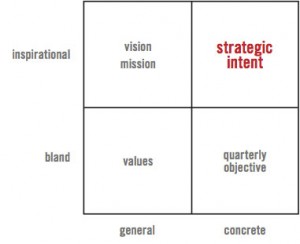An important part of our work in COMM 101 consists in understanding and studying Business Plans. I have to admit that I had never looked at such kind of documents before having to do it in class and one thing that surprised me right away are the mission and vision statements of most Business Plans. I found it interesting to emphasize in a Business Plan the big picture, the direction of the company’s strategy. However, I found some of these statements pretty empty, idealistic, immeasurable and closer to poetry than Business. Come on, we aren’t that credulous! 🙂

Today, I was happy to read in the Harvard Business Review a blog post by Gregory McKeown, the young CEO of THIS Inc. (leadership and strategy design agency), sharing the same opinion than me. In his post “If I Read One More Platitude-Filled Mission Statement, I’ll Scream” (October 4, 2012), McKeown gives three advices to formulate both concrete and inspirational mission statements that he calls strategic intents:
First of all, businesses/organizations should stop “wordsmithing and start deciding”. Clarity and concreteness empower: a strategic intent should be the “decision that makes 1,000 decisions.” It should be precise enough to be constantly confronted with the question “Does this new idea really help us to achieve our intent?” Secondly, businesses/organizations should ask “Will we know when we are done?” The mission to eliminate hunger in the world is grandiose but if the NGO counts 5 members, such statement doesn’t make it credible. Finally, businesses/organizations should move from having a pretty clear statement to having a very clear statement.
Myself being somehow inclined to beat around the bush while embroidering double-talk sentences, I wish that I will remember these advices in my future career. 🙂







